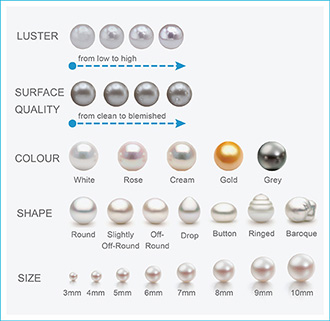US$0.00
About Us
Our Buying Guides
Material Guides
GOLD JEWELLERY
Due to its range in softness based on its purity, gold is the easiest metal to work with. It is important to know the different descriptions of gold such as Fine Gold, Gold-Plated and Gold-Filled, when making your choice of gold jewellery.
Fine Gold: Pure gold mixed with alloys to create solid gold with different karat values: from the least, 10k gold to the highest, 24k gold. Alloys are added to strengthen gold which is very soft.
Gold-Plated: A thin layer of solid gold added to the jewellery, usually in 12k and rubs off easily.
Gold-Filled: Solid gold is rolled out into a sheet and then applied to a base metal through heat — applying a thick plate of gold.
Gold Vermeil:Jewellery made of gold vermeil is higher in quality than gold-plated pieces but less expensive than solid gold. To create vermeil, sterling silver is covered in a layer of gold that is minimum 10 karats and 1.5 microns thick. This vermeil looks like pure gold to the naked eye. It can be polished for a glossy look or left to tarnish for a hint of vintage style.
Yellow Gold: Yellow gold is made by mixing pure gold with silver, copper, and zinc. It is the purest color, the most hypo-allergenic, and requires the least maintenance of all the gold colors.
White Gold: White gold is made of gold and platinum (or palladium). White gold can also be made of gold, palladium, nickel and zinc. White gold is more durable and scratch-resistant than yellow gold. It is also more affordable than both yellow gold and platinum.
Rose Gold: Rose gold (or pink gold) is alloyed with gold, copper, and silver. Rose gold is more affordable than the other gold colors because it uses the inexpensive copper for its rose color. Due to its copper content, rose gold is more durable than yellow or white gold.
Green Gold: Green gold (or Electrum) is mixed with gold, silver, and sometimes copper. Silver is what gives the gold alloy the green nuance.
Fine Gold: Pure gold mixed with alloys to create solid gold with different karat values: from the least, 10k gold to the highest, 24k gold. Alloys are added to strengthen gold which is very soft.
Gold-Plated: A thin layer of solid gold added to the jewellery, usually in 12k and rubs off easily.
Gold-Filled: Solid gold is rolled out into a sheet and then applied to a base metal through heat — applying a thick plate of gold.
Gold Vermeil:Jewellery made of gold vermeil is higher in quality than gold-plated pieces but less expensive than solid gold. To create vermeil, sterling silver is covered in a layer of gold that is minimum 10 karats and 1.5 microns thick. This vermeil looks like pure gold to the naked eye. It can be polished for a glossy look or left to tarnish for a hint of vintage style.
Gold Common Colours
The color gold is cousin to the color yellow and the color brown and is a precious metal that is associated with wealth, grandeur, and prosperity, as well as sparkle, glitz, and glamour.Yellow Gold: Yellow gold is made by mixing pure gold with silver, copper, and zinc. It is the purest color, the most hypo-allergenic, and requires the least maintenance of all the gold colors.
White Gold: White gold is made of gold and platinum (or palladium). White gold can also be made of gold, palladium, nickel and zinc. White gold is more durable and scratch-resistant than yellow gold. It is also more affordable than both yellow gold and platinum.
Rose Gold: Rose gold (or pink gold) is alloyed with gold, copper, and silver. Rose gold is more affordable than the other gold colors because it uses the inexpensive copper for its rose color. Due to its copper content, rose gold is more durable than yellow or white gold.
Green Gold: Green gold (or Electrum) is mixed with gold, silver, and sometimes copper. Silver is what gives the gold alloy the green nuance.
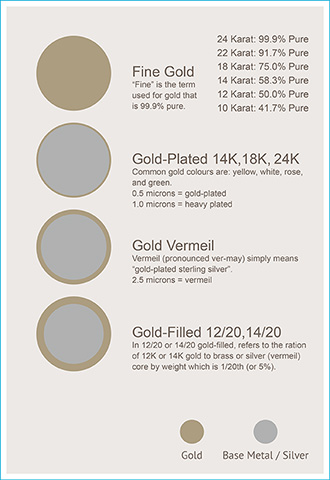
SILVER JEWELLERY
Silver, like gold, with its variety of purity levels, has been frequently used in jewellery. As it is very soft and damages easily, silver is mixed with other metals to improve its durability to make different types of silver jewellery.
Fine Silver: With a .999 level of purity, also known as pure silver. Not suitable for jewellery that are worn regularly, as it is less durable and bends easily.
Sterling Silver: An alloy containing a mixture of 92.5% pure silver and 7.5% of another metal like copper.
Argentium Silver: Argentium's 935 and 960 grades set new purity standards for silver, and are purer than traditional sterling silver. Brighter and whiter than platinum, white gold and traditional sterling, it requires no plating. With a natural colour of pure silver, argentium is a perfect choice for those who are unable to wear traditional sterling silver and is easy to care for and simple to clean.
Silver-Filled: Silver-filled is a thick layer of .925 Sterling Silver mechanically bonded to Copper, hundreds of times thicker and more durable than silver-plated.
Fine Silver: With a .999 level of purity, also known as pure silver. Not suitable for jewellery that are worn regularly, as it is less durable and bends easily.
Sterling Silver: An alloy containing a mixture of 92.5% pure silver and 7.5% of another metal like copper.
Argentium Silver: Argentium's 935 and 960 grades set new purity standards for silver, and are purer than traditional sterling silver. Brighter and whiter than platinum, white gold and traditional sterling, it requires no plating. With a natural colour of pure silver, argentium is a perfect choice for those who are unable to wear traditional sterling silver and is easy to care for and simple to clean.
Silver-Filled: Silver-filled is a thick layer of .925 Sterling Silver mechanically bonded to Copper, hundreds of times thicker and more durable than silver-plated.
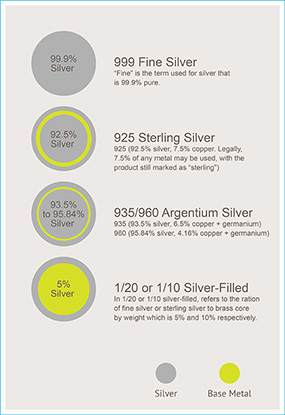
DIAMOND
Historically, diamonds have been the most highly valued of gemstones and have gained a reputation as the ultimate declaration of love. The quality of diamonds are graded using the 4C’s grading system — the Cut, Color, Clarity and Carat that make each diamond uniquely beautiful. Understanding this language will help you to choose the right diamond.
These rare specimens come in every color of the spectrum, including, most importantly, blue, green, pink, and red. Gem diamonds in the D-to-Z range decrease in value as the color becomes more obvious while fancy color diamonds generally increase with the strength and purity of the color. Many fancy diamond colors are muted rather than pure and strong and large, vivid fancy color diamonds are extremely rare and very valuable.
The most rare colours are red, green, purple, and orange, followed by pink and blue while yellows and browns are the most common fancy colors. Blacks, grays, and fancy whites are considered fancies too.
Spectacular prices in high-profile auctions have increased awareness of fancy color diamonds. Many people, though consider yellow and brown fancies less desirable than near-colorless stones of equal weight and clarity.
For more information, visit www.gia.edu
Diamonds in Fancy Colors
Diamonds in the normal color range are colorless through light yellow and are described using the industry’s D-to-Z color-grading scale. Fancy color diamonds, on the other hand, are yellow and brown diamonds that exhibit color beyond the Z range, or diamonds that exhibit any other color face-up.These rare specimens come in every color of the spectrum, including, most importantly, blue, green, pink, and red. Gem diamonds in the D-to-Z range decrease in value as the color becomes more obvious while fancy color diamonds generally increase with the strength and purity of the color. Many fancy diamond colors are muted rather than pure and strong and large, vivid fancy color diamonds are extremely rare and very valuable.
The most rare colours are red, green, purple, and orange, followed by pink and blue while yellows and browns are the most common fancy colors. Blacks, grays, and fancy whites are considered fancies too.
Spectacular prices in high-profile auctions have increased awareness of fancy color diamonds. Many people, though consider yellow and brown fancies less desirable than near-colorless stones of equal weight and clarity.
For more information, visit www.gia.edu
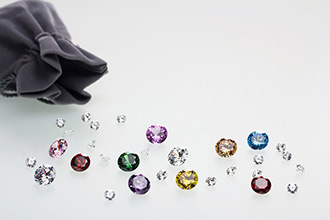
Cut
This refers to the diamond's shape and its quality, determined by its proportions, symmetry and polish. The best-selling diamond cut shape is the round brilliant. Other cut shapes, also known as fancy cut include princess, marquise, pear, heart, oval, emerald, radiant, cushion and Asscher.

Colour
Choose the right colour for your diamond according to your personal preference. Remember that you are generally searching for a stone with little to no colour. The colour of gem-quality diamonds is evaluated on the absence of colour. The Gemological Institute of America (GIA) uses a 12-letter alphabetical scale of D to Z. The diamond on the lower end of the scale (D) will have the least amount of colour (considered a colourless stone.) while at the higher end of the scale (Z), it has deeper tones.

Carats
Of the 4Cs, Carat weight, the weight of a diamond, is the easiest to understand. One carat is equal to 200 milligrams or 0.2 grams. The carat is sub-divided into 100 equal parts called 'points.' One point equals .01 carat or 1/100 carat, thus a one carat diamond equals 100 points. Carat weight is written in decimal numbers, but it is frequently expressed in fractions, for easy understanding. Diamond weight fractions are approximate and refer to ranges of weight.

Clarity
The diamond's clarity is a description of its internal purity. It has a higer value and is more rare with fewer imperfections within the stone. All diamonds are systematically graded and plotted under 10X magnification. If a trained grader cannot see a clarity characteristic at 10X, it does not affect the clarity grade.
Five Factors That Determine Clarity: Size, Number, Position, Nature, Color.
Five Factors That Determine Clarity: Size, Number, Position, Nature, Color.

Gem Cut

Gem Shape

12 Month Birth-Stones

JADE
Jade — a precious gem also known as “the stone of Heaven” — is considered pure, sensous and luxurious – attracting both Asian and international buyers and consumers for its beauty, durability and rarity. Jade is the official gem for the 12th anniversary.
There are 2 descriptions of jade: Jadeite which comes in a wide range of attractive colors from green, yellow, reddish orange to light purple or lavendar, white, black, brown and gray, and Nephrite which ranges from translucent to opaque colours of dark green, yellow, black, white, brown or gray.
Today, the term “jade” is widely used by gemologists for both jadeite and nephrite.
There are 2 descriptions of jade: Jadeite which comes in a wide range of attractive colors from green, yellow, reddish orange to light purple or lavendar, white, black, brown and gray, and Nephrite which ranges from translucent to opaque colours of dark green, yellow, black, white, brown or gray.
Today, the term “jade” is widely used by gemologists for both jadeite and nephrite.
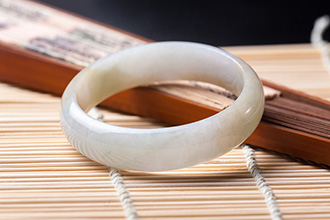
Colour — This is the most important value factor in jadeite and the most desirable colour is a very specific shade of green, followed by Lavendar. “Imperial Jade” is the finest-quality jadeite with a vibrant emerald-green, almost transparent colour.
Transparency — Jadeite’s transparency ranges from completely opaque (least desirable) to semi-transparent (best). Good transparency can make up for lack of uniform colour or low colour saturation.
Texture — Jadeite’s smooth and even texture can be fine, medium, or coarse, depending on variations in crystal size and hardness. This same crystal structure also contribute to its exceptional toughness to withstand breakage.
Cut — China is the world’s main polishing center for jadeite. Many cutters, today, still polish jadeite the traditional way, with a hollow bamboo lathe treated with sand and water. Jadeite are fashioned into different jewelry items such as bangles, rings, and pendants which are carved entirely from a single piece; also known as Hololiths. The finest-quality jadeite are cut into cabochons for rings and other jewelry while fine-quality jadeite are cut into round beads and strung into strands.
Size & Weight — Jadeite size is commonly expressed in millimeters. The value of cabochons, beads, and bangle bracelets rises with an increase in size, all other quality factors being equal. With top-quality imperial jadeite, slight differences in size can make large differences in value. With nephrite, larger sizes do not raise the value dramatically in most cases.
Transparency — Jadeite’s transparency ranges from completely opaque (least desirable) to semi-transparent (best). Good transparency can make up for lack of uniform colour or low colour saturation.
Texture — Jadeite’s smooth and even texture can be fine, medium, or coarse, depending on variations in crystal size and hardness. This same crystal structure also contribute to its exceptional toughness to withstand breakage.
Cut — China is the world’s main polishing center for jadeite. Many cutters, today, still polish jadeite the traditional way, with a hollow bamboo lathe treated with sand and water. Jadeite are fashioned into different jewelry items such as bangles, rings, and pendants which are carved entirely from a single piece; also known as Hololiths. The finest-quality jadeite are cut into cabochons for rings and other jewelry while fine-quality jadeite are cut into round beads and strung into strands.
Size & Weight — Jadeite size is commonly expressed in millimeters. The value of cabochons, beads, and bangle bracelets rises with an increase in size, all other quality factors being equal. With top-quality imperial jadeite, slight differences in size can make large differences in value. With nephrite, larger sizes do not raise the value dramatically in most cases.
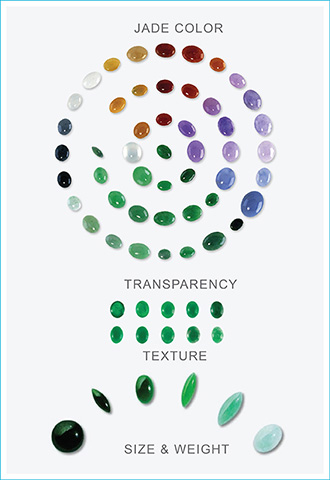
PEARL
One of the most-loved gems through the centuries, both natural and cultured pearls are available in a wide variety of colors, besides the popular white and cream. Some pearls also show the iridescent phenomenon known as orient. Natural pearls occur around a microscopic irritant in the bodies of certain mollusks while cultured pearls are formed through the insertion of a bead or piece of tissue which the mollusk coats with nacre.
For both, the quality of the nacre will affect the luster or shine of the pearl, adding to its beauty and value. Pearls should be smooth and free of marks in round, oval or pear shapes. Misshapen pearls are also called baroque pearls.
Cultured pearls are popular as bead necklaces and bracelets, mounted in solitaires, pairs, or clusters in earrings, rings, and pendants. Pearl is the birthstone for June and the gem of the third and thirtieth anniversaries.
For both, the quality of the nacre will affect the luster or shine of the pearl, adding to its beauty and value. Pearls should be smooth and free of marks in round, oval or pear shapes. Misshapen pearls are also called baroque pearls.
Cultured pearls are popular as bead necklaces and bracelets, mounted in solitaires, pairs, or clusters in earrings, rings, and pendants. Pearl is the birthstone for June and the gem of the third and thirtieth anniversaries.
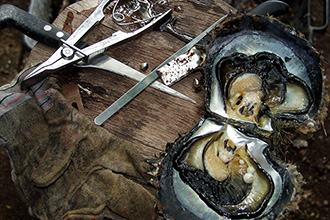
Natural Pearls — Very rare and costly. Historically, they were found in the Persian Gulf although today, most have been harvested. Cultured Pearls — grown in pearl farms. Not all will produce a pearl and not all cultured pearls are of a high quality. For example, over 10,000 pearls may be sorted to produce a 16” single strand of beautifully matched pearls.
Saltwater Pearls — They include the Akoya cultured pearls grown in Japanese and Chinese waters in white and cream colors. from 2mm to 10mm in size, South Sea pearls (the largest of all pearls) from Australia, Indonesia and the Philippines, in white, cream and golden, from 9mm to 20mm and Tahitian pearls from French Polynesia and Tahiti, in natural black, gray, green, blue and purple, from 8mm to 16mm.
Freshwater Pearls — Grown in freshwater lakes, rivers and ponds and mainly in China, these pearls are produced in various shapes and pastel colours although many are white and resemble the Akoya cultured pearls. Many freshwater pearls do not have a bead nucleus, and only a piece of tissue, hence a thicker nacre in the pearl.
Imitation Pearls — Most have a high luster as they are coated glass beads, though not the depth of luster of high quality cultured pearls. Always seek the advice of a respected jeweller who can spot the imitations from cultured or natural pearls.
Saltwater Pearls — They include the Akoya cultured pearls grown in Japanese and Chinese waters in white and cream colors. from 2mm to 10mm in size, South Sea pearls (the largest of all pearls) from Australia, Indonesia and the Philippines, in white, cream and golden, from 9mm to 20mm and Tahitian pearls from French Polynesia and Tahiti, in natural black, gray, green, blue and purple, from 8mm to 16mm.
Freshwater Pearls — Grown in freshwater lakes, rivers and ponds and mainly in China, these pearls are produced in various shapes and pastel colours although many are white and resemble the Akoya cultured pearls. Many freshwater pearls do not have a bead nucleus, and only a piece of tissue, hence a thicker nacre in the pearl.
Imitation Pearls — Most have a high luster as they are coated glass beads, though not the depth of luster of high quality cultured pearls. Always seek the advice of a respected jeweller who can spot the imitations from cultured or natural pearls.
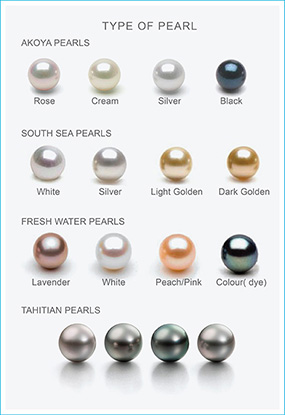
Luster — Pearls with high luster have sharp bright reflections on the surface.
Surface Quality — The number of blemishes on a pearl's surface is evaluated to judge quality.
Colour — Although white is most classic, appreciation has grown for more unusual natural colors.
Shape — Spherical pearls are the most valued but symmetrical drops are also sought.
Size — Depending on the mollusk used, cultured pearls range from 2-16mm in diameter.
Nacre Thickness — Evaluated to ensure that cultured pearls are durable as well as beautiful.
Matching — For pearl strands and multi-pearl pieces, how well the pearls match (or mix) affects the value.
Surface Quality — The number of blemishes on a pearl's surface is evaluated to judge quality.
Colour — Although white is most classic, appreciation has grown for more unusual natural colors.
Shape — Spherical pearls are the most valued but symmetrical drops are also sought.
Size — Depending on the mollusk used, cultured pearls range from 2-16mm in diameter.
Nacre Thickness — Evaluated to ensure that cultured pearls are durable as well as beautiful.
Matching — For pearl strands and multi-pearl pieces, how well the pearls match (or mix) affects the value.
